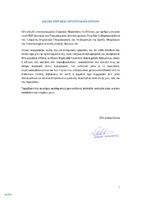| dc.contributor.advisor | Μαυρομμάτης, Κωνσταντίνος | |
| dc.contributor.author | Μιχαλάκης, Ζαχαρίας | |
| dc.date.accessioned | 2023-03-20T11:14:43Z | |
| dc.date.available | 2023-03-20T11:14:43Z | |
| dc.date.issued | 2023-01-21 | |
| dc.identifier.uri | https://polynoe.lib.uniwa.gr/xmlui/handle/11400/3977 | |
| dc.identifier.uri | http://dx.doi.org/10.26265/polynoe-3817 | |
| dc.description.abstract | The dangers in cyberspace are a new reality that during the last years is
threatening the shipping sector as well. In earlier times, cyberspace was not
considered at all by the shipping industry as there were other priorities that had
to be addressed. Cyber risk management refers to the process of identifying,
analyzing, evaluating and reporting a cyber threat. In the light of the
unprecedented situation that the shipping industry is experiencing with the ever-
increasing trend of cyber attacks, the international shipping community is in
constant vigilance for the issuance of guidelines, recommendations and
instructions, which will be the basis for future international treaties governing
the issue of cyber security. It is therefore appropriate to note the first impacts
of the legislation on this new problem and, if necessary, at any appropriate time
to make any new legislative interventions and to be able to correct incorrect
texts in a timely manner. It is important that every ship owner to be prepared
for a cyber attack because it is not a science fiction scenario. Only by having
this mentality, but also securing the cooperation of all stakeholders of the supply
chain, the shipping industry will at least limit this issue to a significant degree.
It is recommended that a shipping company first conduct a potential threat
assessment that may occur. This should be followed by an evaluation of the
systems and on - board procedures for mapping robustness and addressing
the current threat level. The result of the company Risk Assessment and the
subsequent strategy for cyber security should be the reduction of cyber threats. | el |
| dc.format.extent | 50 | el |
| dc.language.iso | en | el |
| dc.publisher | Πανεπιστήμιο Δυτικής Αττικής | el |
| dc.publisher | State University of Moldova | en |
| dc.publisher | Technical University of Moldova | en |
| dc.publisher | Academy of Economic Studies of Moldova | en |
| dc.publisher | Alecu Russo State University of Bălți | en |
| dc.publisher | L. N. Gumilyov Eurasian National University | en |
| dc.rights | Αναφορά Δημιουργού - Μη Εμπορική Χρήση - Παρόμοια Διανομή 4.0 Διεθνές | * |
| dc.rights | Attribution-NonCommercial-NoDerivatives 4.0 Διεθνές | * |
| dc.rights.uri | http://creativecommons.org/licenses/by-nc-nd/4.0/ | * |
| dc.subject | Κυβερνοασφάλεια | el |
| dc.subject | Ναυτιλία | el |
| dc.title | Cybersecurity in maritime | el |
| dc.title.alternative | Κυβερνοασφάλεια στη ναυτιλία | el |
| dc.type | Μεταπτυχιακή διπλωματική εργασία | el |
| dc.contributor.committee | Γιαννακόπουλος, Παναγιώτης | |
| dc.contributor.committee | Gritzalis, Stefanos | |
| dc.contributor.faculty | Σχολή Μηχανικών | el |
| dc.contributor.department | Τμήμα Μηχανικών Πληροφορικής και Υπολογιστών | el |
| dc.contributor.master | Κυβερνοασφάλεια | el |



